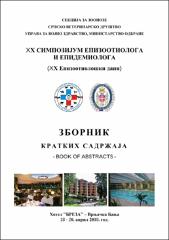Širenje bolesti plavog jezika na teritoriji Mačvanskog i Kolubarskog okruga i uticaj vakcinacije na suzbijanje bolesti u periodu 2014-2018. godine

View/
Date
2018Author
Vujinović, Slobodan
Maksimović, Slobodan
Mrkovački, Stevan
Pelić, Miloš
Tomić, Srđan
Metadata
Show full item recordAbstract
This paper describes a retrospective analysis of the appearance bluetongue disease (BTD) on the VSI “Šabac” epizootiological area during the period 2014-2018.Disease was first reported in a herd of sheep in the municipality Vladimirci in 2014. The sources of infection were sheep from a neighbouring yard, where they were slaughtered. Animals were illegally transported from eastern Serbia, where at that time was a focal points of BTD. This focal point was registered in late autumn, and disease has not spread further from this area. Entomological study was carried out from 2015 to the present, and psychotropic Culicoides species were determined. Vaccination of susceptible animals was conducted during May-June 2016 at the territory of Mačva district, bordering zone with Bosnia and Herzegovina. Vaccination coverage ranged from 0% to 95% in different places. In autumn 2016 outbreak registered precisely in the area where the vaccination coverage was poor and where vaccination was partially implemented. This clearly indicates that the vaccination zone had to be wider, as well as to the planning of partial vaccination should take into account the characteristics of the terrain topography that influence the direction of the winds near the ground. In this particular case is a clear noticeable impact of the Valjevo mountain range, which direct the west wind, as well as infectious diseases which can be transmitted by air or insects over long distances. In 2016, BTD was diagnosed in 282 yards. We assume that in this period the BTD on Mačva and Kolubara district was transmitted from Bosnia and Herzegovina, which had reported a numbers of positive cases. During 2017 vaccination of all susceptible animals was conducted on the territory of Serbia and on Mačva and Kolubara district and no case was recorded. Effects of global climate changes and the influence of local climatic conditions on the spread of BTD, the existence of a large number of serotypes that causes incomplete vaccination, the existence of psychrotrophic species of Culicoides, trafficking, vaccination of susceptible animals in environment must be taken into account while planning future plans for control and eradication of this disease.
